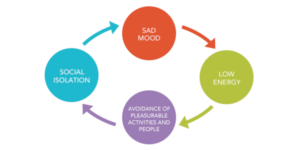Mental illness, one of the most prevalent mental health challenges worldwide, can be an incredibly isolating experience. However, there’s a growing body of evidence suggesting that our behaviors can either feed this darkness or help illuminate our way out of it. One therapeutic approach that emphasizes this connection is Behavioral Activation Therapy. In this blog, we will dive deep into what Behavioral Activation Therapy is, its fundamental principles, and how it can serve as a transformative tool in one’s mental health journey.
Contents
What Is Behavioral Activation Therapy?
 Behavioral Activation Therapy (BAT) is a cognitive-behavioral therapy approach specifically designed to treat depression. It operates on the principle that certain behaviors can either exacerbate or alleviate depressive symptoms. BAT posits that by avoiding distressing situations or tasks, individuals inadvertently reinforce their depressive mood.
Behavioral Activation Therapy (BAT) is a cognitive-behavioral therapy approach specifically designed to treat depression. It operates on the principle that certain behaviors can either exacerbate or alleviate depressive symptoms. BAT posits that by avoiding distressing situations or tasks, individuals inadvertently reinforce their depressive mood.
Instead, BAT encourages individuals to understand the connection between their behavior, emotions, and thoughts. And to actively engage in activities that align with their values and bring them joy, thereby breaking the cycle of depression.
Central to BAT is the idea of “activation.” This means helping individuals identify and engage in activities that are positive and meaningful to them. The goal is to change patterns of behavior and replace them with behaviors that promote well-being and a positive mood.
What Are The Core Principles of BAT?
Behavioral Activation Therapy (BAT) is built on several core principles that address the interplay between behavior, emotions, and thoughts, specifically as they pertain to depression. Here are the central tenets of BAT:
Behavior-Mood Connection
One of the foundational ideas of BAT is that behaviors can influence mood. Engaging in certain activities (or avoiding them) can either mitigate or exacerbate depressive symptoms. By recognizing and acting upon this connection, individuals can start to have more control over their emotional well-being.
Role of Avoidance
Avoidance behaviors, like withdrawing from social situations or neglecting hobbies, often stem from the desire to escape negative feelings. However, they can inadvertently perpetuate and deepen depression. BAT emphasizes the need to identify and challenge these avoidance behaviors.
Activation
Contrary to avoidance, activation involves deliberately choosing and engaging in activities that are aligned with an individual’s values, interests, or goals. The objective is not just to be busy, but to engage in meaningful actions that can foster positive emotions.
Breaking the Cycle
Mental illness or any depressive thoughts can create a self-sustaining cycle where a negative mood leads to reduced activity. In turn, this further deepens the depressive state. BAT aims to break this cycle by reintroducing positive, value-driven behaviors, which can then elevate mood.
Functional Analysis
This involves examining the causes and consequences of specific behaviors. Understanding the triggers and outcomes of certain actions helps in identifying which behaviors to target and how to modify them.
Value-driven Actions
Rather than engaging in activities for the sake of activity, BAT stresses the importance of value-driven actions. This means pursuing tasks and hobbies that align with an individual’s intrinsic values, passions, and long-term goals.
Holistic View
While BAT primarily targets behavior, it recognizes the intricate interplay between thoughts, emotions, and actions. Thus, while the primary focus is on changing behavior, the therapy acknowledges the importance of understanding one’s emotional and cognitive patterns.
By integrating these principles, BAT offers a structured yet flexible approach to addressing depression. And, emphasizing proactive engagement in positive behaviors to uplift mood and overall well-being.
How Does Behavioral Activation Therapy Work?
 Behavioral Activation Therapy (BAT) is a structured, action-oriented approach that aims to help individuals understand and change the patterns of behavior that contribute to their depressive symptoms. Here’s how BAT generally works:
Behavioral Activation Therapy (BAT) is a structured, action-oriented approach that aims to help individuals understand and change the patterns of behavior that contribute to their depressive symptoms. Here’s how BAT generally works:
- Initial Assessment
The process begins with a thorough assessment of the individual’s current behaviors, mood, and environmental context. This provides a clear picture of how one’s behaviors are linked to depressive symptoms.
- Identification of Behaviors
The therapist and the individual collaboratively identify specific activities or situations that the individual is avoiding due to their depressive state. Recognizing these behaviors is critical, as they often serve to maintain or worsen depression.
- Setting Activation Goals
Based on the insights from the assessment and functional analysis, specific and achievable goals are set. These goals involve increasing engagement in activities that can boost mood and are aligned with the individual’s values and interests.
- Activity Scheduling
A systematic plan is created to reintroduce and increase engagement in positive, mood-elevating activities. This might involve creating a weekly schedule of tasks and hobbies that the individual finds rewarding.
- Gradual Exposure to Avoided Activities
To break the cycle of avoidance, individuals are encouraged to gradually confront and engage in activities they’ve been avoiding. Over time, this exposure helps reduce the fear or negativity associated with these tasks and situations.
- Monitoring and Feedback
Throughout the therapy, individuals are encouraged to monitor their moods, activities, and responses. Regular feedback sessions with the therapist help in tracking progress and making necessary adjustments.
- Relapse Prevention
As the therapy progresses, strategies are introduced to help individuals maintain the positive changes they’ve achieved and to prevent relapses into depressive states.
Throughout the process, the therapist provides support, guidance, and encouragement. This is to help the individual navigate challenges and celebrate achievements. The ultimate goal of BAT is to equip individuals with the tools and insights they need to lead fulfilling lives.
Who Can Benefit From It?
Behavioral Activation Therapy has been primarily developed for treating depression. However, its principles and techniques can be beneficial for various individuals. Here’s a breakdown of who might benefit from BAT:
- Individuals with Major Depressive Disorder (MDD): BAT has shown significant effectiveness in treating individuals with MDD. Especially those who experience a decrease in pleasure from previously enjoyable activities or those who tend to avoid situations due to their mood.
- Those with Persistent Depressive Disorder: Formerly known as dysthymia, this long-term form of depression can also be addressed using BAT.
- Individuals with Co-morbid Conditions: People who suffer from depression alongside other disorders. Such as anxiety or substance use disorders, can benefit from BAT.
- People with Situational Depression: Those who experience depressive symptoms due to specific life events (like bereavement, job loss, or other significant life changes) might find BAT helpful in re-engaging with life and reducing avoidance behaviors.
- Individuals with Treatment-resistant Depression: Some individuals might not respond well to traditional therapies or medications. BAT offers an alternative or supplemental approach for these individuals, focusing on actionable behavioral changes.
- Older Adults: Research suggests that BAT can be particularly effective for older adults, who might struggle with decreased activity levels or increased life stressors contributing to depressive symptoms.
While BAT has wide applicability, it’s essential to note that therapy’s effectiveness can vary from one individual to another. So, it’s crucial for individuals to consult with mental health professionals to determine if this is the most appropriate treatment option for them.
How To Find Behavioral Activation Therapy Near Me?
 If you’re looking to find Behavioral Activation Therapy (BAT) services near you, follow these steps:
If you’re looking to find Behavioral Activation Therapy (BAT) services near you, follow these steps:
- Professional Associations
Many countries have psychological or psychiatric associations with directories of licensed therapists. Check their websites to search for therapists who specialize in BAT.
- Online Directories
Websites like MantraCare, TherapyMantra, and GoodTherapy allow you to search for therapists based on your location and the type of therapy you’re seeking.
- Local Mental Health Clinics
Contact clinics or mental health centers in your area. They often have a list of therapists and their specialties.
- University Psychology Departments
If you live near a university with a psychology or psychiatry department, they might have a clinic that offers therapy services, or they can recommend local practitioners.
- Teletherapy Platforms
With the rise of online therapy platforms like TherapyMantra and BetterHelp, you can access BAT remotely. While this isn’t “near” in a physical sense, it brings the therapy to you, wherever you are.
- Referrals
Ask your primary care doctor, psychiatrist, or another healthcare provider for referrals. They often have a network of therapists they can recommend.
- Social Media
Many therapists and therapy centers have active social media profiles. A quick search for “Behavioral Activation Therapy” along with your location might yield some local results.
Remember, once you identify potential therapists, it’s essential to ensure they’re licensed and have the appropriate credentials. It’s also beneficial to have an initial consultation to determine if you feel comfortable with the therapist.
Conclusion
In the multifaceted realm of mental health treatments, Behavioral Activation Therapy (BAT) emerges as a transformative, evidence-based approach that centers on the powerful interplay between behavior and mood. Whether you’re grappling with persistent depressive symptoms, situational challenges, or seeking a proactive pathway to mental well-being, BAT offers actionable steps to re-engage with life’s joys and combat avoidance behaviors.
Remember, every therapeutic journey is personal. While BAT may be a beacon for many, it’s crucial to consult with professionals to determine the best route for your unique mental health needs. If you are looking for affordable Online Therapy TherapyMantra can help: Book a trial Online therapy session


